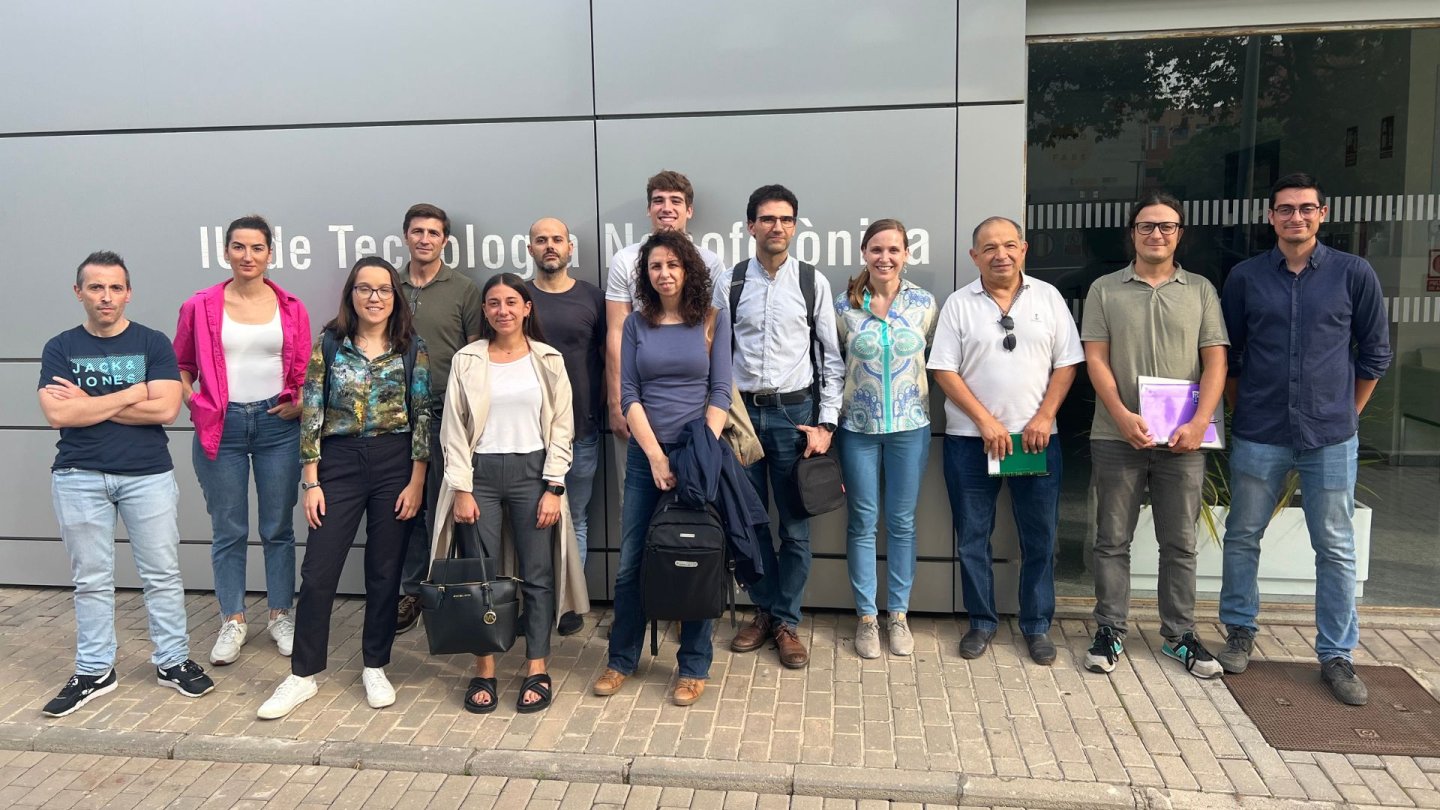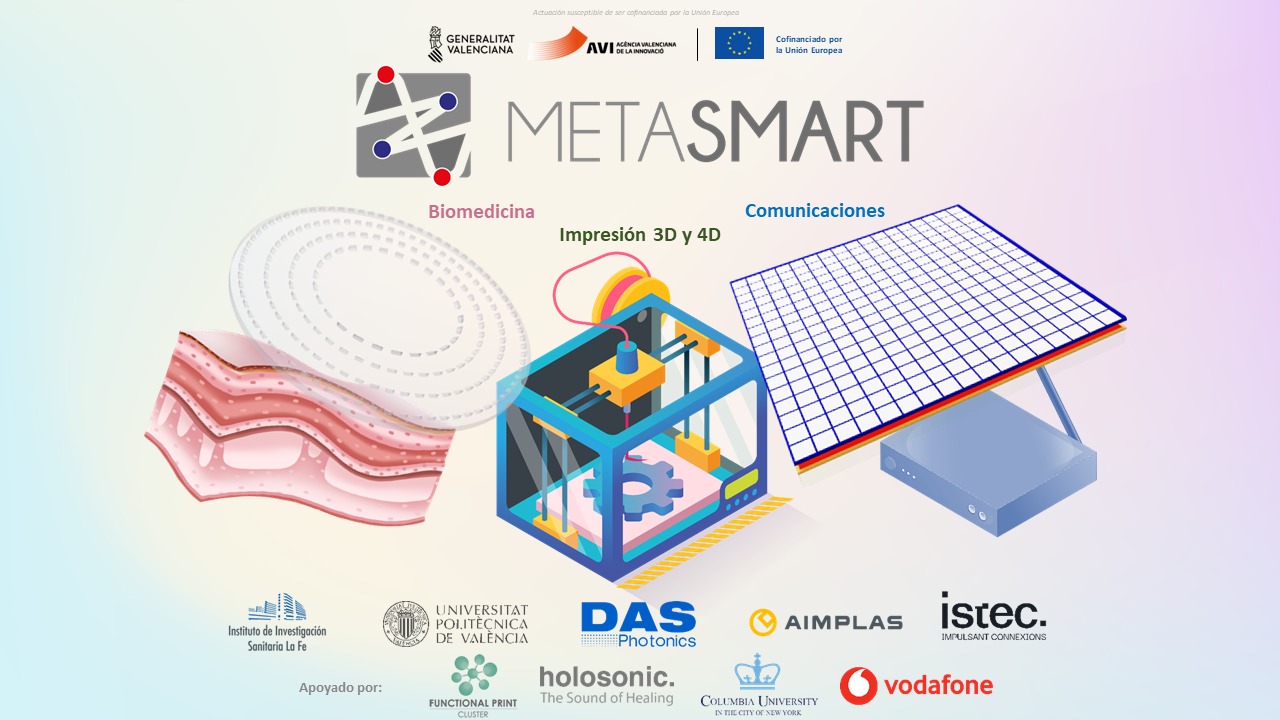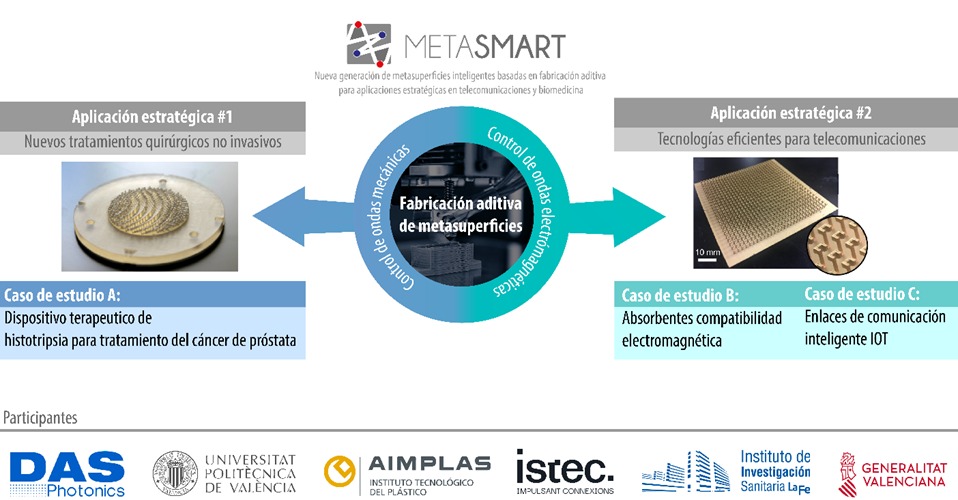News
IIS La Fe contributes to the development of 3D-printed smart materials
From infallible telecommunications to ultrasound-based cancer treatments
The project also involves the UPV, AIMPLAS, and ISTEC, all coordinated by the Valencian company DAS Photonics, and is funded by the Valencian Innovation Agency.

To develop reconfigurable 3D-printed smart metasurfaces to destroy tumours in a much more targeted way - at the histological level - without damaging adjacent healthy tissues, thus achieving a much less aggressive treatment for people diagnosed with cancer. This is one of the objectives of the Metasmart project, an initiative led by the Valencian company DAS Photonics and involving researchers from the Universitat Politècnica de València (UPV), together with AIMPLAS, ISTEC and the La Fe Health Research Institute (IIS La Fe). The project is funded by the Valencian Innovation Agency.
According to the UPV's Nanophotonics Technology Centre (NTC), the metasurfaces are artificial structures designed to manipulate waves of different natures. "They are materials whose properties can be created à la carte, allowing us, for example, to control acoustic waves or electromagnetic waves across the entire spectrum. Their potential is enormous, in many fields, such as biomedicine and, more specifically, in cancer therapies, but also in other sectors, such as telecommunications," adds Carlos García Meca, research director of DAS Photonics, a spin-off of the UPV. However, the current techniques for manufacturing these metasurfaces mean that they are still far from being applied in the industrial environment. And this is another of the great challenges that the Metasmart project is responding to.

"We want to revolutionise the field of metasurfaces by researching new production processes based on additive manufacturing techniques (multi-layer 2D printing of functional materials, 3D and 4D printing) that are versatile, precise and cheap. By using 3D printing we will save material, we will be more environmentally friendly, the prototyping capacity will be higher, we will be able to delocalise production. It will be a before and after in the development and application of these materials," says Sergio Lechago, researcher at DAS Photonics.
Destruction of tumours
Thanks to medical and technological advances in recent decades, the life expectancy of patients diagnosed with cancer is increasing. This vital increase has a toll for many cancer patients, which is often very high in terms of their quality of life (both physically and psychologically) due to the aggressive side effects of many of these treatments.
Noé Jiménez, a researcher at the Instituto de Instrumentación para Imagen Molecular (I3M), a joint centre of the Universitat Politècnica de València and the Spanish National Research Council (CSIC), explains that current thermal ablation treatments affect not only the tumour area, but also the healthy tissues surrounding the tumour. "What we are looking for with these metasurfaces is to destroy it mechanically. In this modality, the ultrasound will act like a hammer, crushing cell by cell, producing a very focused lesion with very delimited borders, at a histological level, so that healthy tissues are not damaged," Jiménez points out.
In this sense, César David Vera Donoso, a physician at the Urology Department of the Hospital La Fe in Valencia and director of the NITIUV Research Group at IIS La FE, which is leading the final clinical application, stresses that the medicine and technology of the future must be capable not only of curing diseases, but also of generating the least possible impact on the patient with increasingly less aggressive and minimally invasive therapies.
"With this idea in mind, the technology proposed in Metasmart will generate concrete solutions based on the use of metasurfaces, initially for the treatment of prostate cancer. As this is the most frequent tumour in men worldwide, histotripsy as a focal treatment in patients with localised cancer aims to achieve a curative treatment that is incorporated into the possibilities we currently have, sparing the patient the side effects of other techniques such as radiotherapy or thermoablation. This would make it possible to treat a very large number of prostate cancer patients," emphasises Dr Vera Donoso.
Improved wireless communications
The Metasmart project also proposes the design and development of reconfigurable 3D electromagnetic metasurfaces capable of manipulating radiated wavefronts. Their application will make it possible to improve and optimise wireless data communications in different frequency bands, avoiding interference and drops in coverage. "In this field, these metasurfaces would help to improve the performance of communication towers, firstly, and ultimately, to optimise our communications," says Ana Díaz, a researcher at the NTC of the Politècnica de València.

The NTC researcher also points out that these metasurfaces could also be integrated into tables, walls, etc. in homes, businesses, etc., creating an intelligent environment that would minimise the chances of, for example, a call being cut off or the network connection dropping.
Top rated project
AIMPLAS, Instituto Tecnológico del Plástico, will carry out research into 2D and 3D multilayer processing technologies for the development of acoustic and electromagnetic metasurfaces. Meanwhile, the work of the ISTEC team will focus on the analysis of applications in the field of communications, the definition of requirements and the validation of prototypes.
Of the hundred or so proposals submitted to the Valencia Innovation Agency's call for 'Strategic Cooperation Projects', METASMART received the best evaluation of the entire call. "It is an initiative that also shows the industrial potential of the Valencia Region to come up with efficient solutions with applications in fields that affect us all, such as health or communications," concludes Carlos García Meca.
The project began in September last year and will conclude at the end of 2024.







